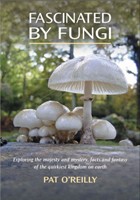Hypoxylon fuscum (Pers.) Fr. - Hazel Woodwart
Phylum: Ascomycota - Class: Sordariomycetes - Order: Xylariales - Family: Xylariaceae
Distribution - Taxonomic History - Etymology - Identification - Reference Sources
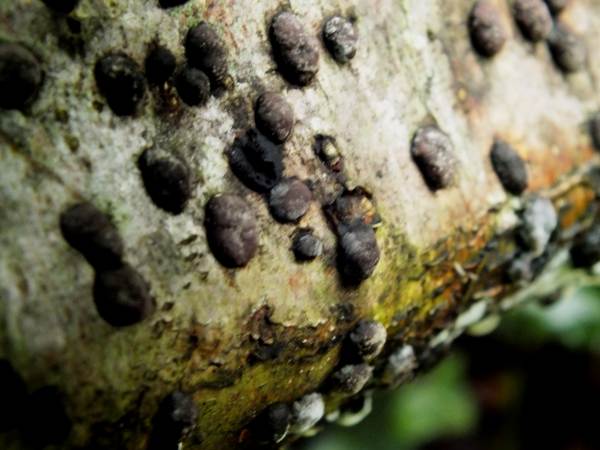
Hypoxylon fuscum, commonly called the Hazel Woodwart, appears throughout the year but actively distributes its spores during autumn and early winter. This wood-rotting fungus is one of the pyromycetes or flask fungi.
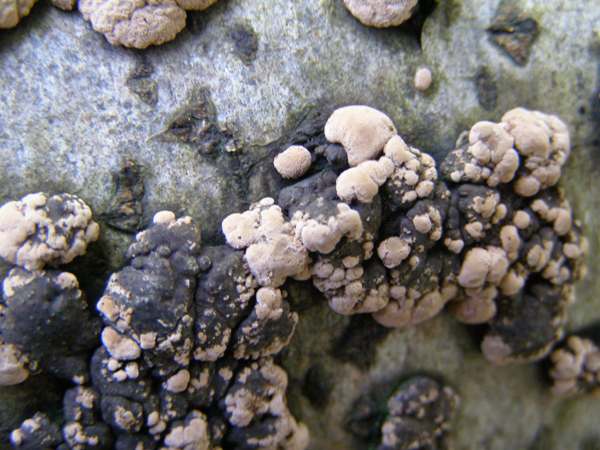
Above: Hazel Woodwart can produce conidiaspores at any stage of its development. Here the pale colouring on the stromata surfaces is evidence of the anamorph (conidia reproduction) stage.
Distribution
A common species in Britain and Ireland, Hypoxylon fuscum is found also throughout mainland Europe and in many parts of North America.
Taxonomic history
The scientific name Sphaeria fusca was given to this ascomycetous fungus in 1794 by Christiaan Hendrick Persoon, but its currently accepted name Hypoxylon fragiforme dates from 1849, when Swedish mycologist Elias Magnus Fries transferred Hazel Woodwart to the genus Hypoxylon.
The many synonyms of Hypoxylon fusca include Sphaeria fusca Pers., Cladotrichum fuscum (Pers.) Sacc., Hypoxylon glomerulatum Bull., Sphaeria coryli DC.. & Lam., and Sphaeria tuberculosa Bolton.
Etymology
The genus name hypoxylon comes from hypo- meaning beneath (or less than) and -xylon meaning wood. The specific epithet fuscum comes from Latin and means dark or dusky.
Identification guide
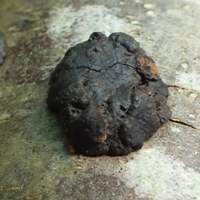 |
DescriptionStroma (plural stromata) - the name given to the communal fruitbody of an ascomycete fungi - hemispherical or hemi-ellipsoidal, 2 to 5mm in diameter and 0.5-2mm tall, often coalescing; initially creamy-white to honey-coloured, becoming dark vinaceous brown at maturity before blackening when old. |
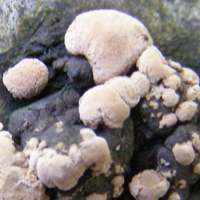 |
ConidiaAt the anamorph (asexual reproduction) stage - especially when the stromata are just forming, but it can occur at any stage - the stromata surfaces become powdery and buff to honey-coloured as sub-spherical conidiospores 3.5-5.5 x 2-3.5µm develop on the surface. |
AscosporesElongated ellipsoidal to fusiform with sharply rounded ends, sometimes slightly allantoid (sausage shaped to bean shaped), smooth, 11-16 x 5-8µm. Spore printBrown. AsciTypically 105-170 x 7-10µm, with eight spores per ascus; tips amyloid. |
|
Odour/taste |
Not distinctive. |
Habitat & Ecological role |
Saprobic, on fallen branches and dead standing broad-leaf trees, most often Hazel. |
Season |
Throughout the year, but producing ascospores in autumn and early winter. |
Similar species |
Hypoxylon fragiforme is nearly always found on dead Beech wood. |
Reference Sources
Fascinated by Fungi, 2nd Edition, Pat O'Reilly 2016, reprinted by Coch-y-bonddu Books in 2022.
Dennis, R.W.G. (1981). British Ascomycetes; Lubrecht & Cramer; ISBN: 3768205525.
Breitenbach, J. & Kränzlin, F. (1984). Fungi of Switzerland. Volume 1: Ascomycetes. Verlag Mykologia: Luzern, Switzerland.
Medardi, G. (2006). Ascomiceti d'Italia. Centro Studi Micologici: Trento.
Dictionary of the Fungi; Paul M. Kirk, Paul F. Cannon, David W. Minter and J. A. Stalpers; CABI, 2008.
Fascinated by Fungi. Back by popular demand, Pat O'Reilly's best-selling 450-page hardback book is available now. The latest second edition was republished with a sparkling new cover design in September 2022 by Coch-y-Bonddu Books. Full details and copies are available from the publisher's online bookshop...
